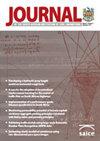使用大规模自动车牌识别(ANPR)数据验证交通模型
IF 0.6
4区 工程技术
Q4 ENGINEERING, CIVIL
Journal of the South African Institution of Civil Engineering
Pub Date : 2019-01-01
DOI:10.17159/2309-8775/2019/v61n3a5
引用次数: 5
摘要
自动车牌识别系统使用车牌识别软件,自动记录每辆经过路边摄像头的车辆的车牌号码、日期/时间和位置。通过多个摄像头的单个车辆记录可以进行匹配,以确定车辆的路径,并计算在调查地点之间的行驶时间。如果摄像机位于封闭的警戒线内,则可以确定通过警戒线的外部行程的起点和目的地。沿着路线或在整个交通网络的重要地点安装一系列的自动定位系统摄影机,并不会观察每一辆进出交通网络的车辆,而是一种开放式车牌调查。封闭和开放格式的ANPR数据都有可能在战略交通模型的开发过程中提供有用的信息,这是其他交通数据来源无法做到的。环路探测器(如ANPR)的综合交通观测提供了链路速度和流量信息,这些信息在交通模型的校准和验证过程中非常有用。但是,ANPR从一个点到另一个点跟踪单个车辆的额外能力也提供了关于网络中行程分布的潜在有用数据。虽然这构成了部分而不是全面的起点-目的地(OD)数据,但它仍然可以作为一个额外的独立数据集,模型输出可以根据它进行验证。ANPR数据很少以这种方式使用。本文的目的是研究在交通模型验证中使用ANPR数据的全面性和准确性。ANPR数据由南非国家公路局SOC有限公司(SANRAL)从部署在豪登省高速公路改善项目(GFIP)上的开放道路收费(ORT)系统中提供。为演示目的,将选定的链路数量和行程时间与GFIP流量模型的2015年预测进行比较。此外,通过提取部分OD和行程长度分布指标,利用ANPR数据的行程分布特征与建模量进行比较。这就需要开发一种新的方法来处理交通模型的输出,使它们可以直接与anpr导出的部分OD数据进行比较。这是模型验证的一个特征,在以前的研究中没有发现。使用大规模自动车牌识别(ANPR)数据验证交通模型本文章由计算机程序翻译,如有差异,请以英文原文为准。
Validating traffic models using large-scale Automatic Number Plate Recognition (ANPR) data
INTRoduCTIoN Automatic Number Plate Recognition (ANPR) entails the automated recording of the number plate, date/time and location of each vehicle that passes a roadside camera, using vehicle number plate recognition software. Records of individual vehicles that pass multiple cameras can be matched to determine the path of the vehicle and calculate travel times between the survey locations. If cameras are in a closed cordon, the origin and destination of external trips passing through the cordon can be determined. A series of ANPR cameras along a route, or at strategic locations throughout a network, would not observe every vehicle upon entry and exit to the network, and constitutes an open format number plate survey. Both closed and open format ANPR data have the potential to provide information that can be useful during the development of strategic traffic models, in ways that are not possible with other sources of traffic data. Comprehensive traffic observations from loop detectors, like ANPR, provide link speed and volume information which is useful during the calibration and validation of traffic models. But the additional ability of ANPR to track individual vehicles from point to point also provides potentially useful data on the distribution of trips through the network. While this constitutes partial rather than comprehensive origin-destination (OD) data, it may still serve as an additional independent data set against which model outputs can be validated. ANPR data has rarely been used in this way. The objective of this paper is to examine the use of ANPR data for traffic model validation in terms of its comprehensiveness and accuracy. ANPR data is provided by the South African National Roads Agency SOC Ltd (SANRAL) from the Open Road Tolling (ORT) system deployed on the Gauteng Freeway Improvement Project (GFIP). Selected link volumes and journey times are, for demonstration purposes, compared with the GFIP traffic model’s 2015 forecasts. In addition, the trip distribution characteristics of the ANPR data are exploited by extracting partial OD and trip length distribution metrics for comparison with modelled quantities. This required the development of a new methodology to process traffic model outputs such that they are directly comparable to ANPR-derived partial OD data. This is a feature of model validation that has not been found in previous studies. Validating traffic models using large-scale Automatic Number Plate Recognition (ANPR) data
求助全文
通过发布文献求助,成功后即可免费获取论文全文。
去求助
来源期刊
CiteScore
0.70
自引率
25.00%
发文量
19
审稿时长
>12 weeks
期刊介绍:
The Journal of the South African Institution of Civil Engineering publishes peer reviewed papers on all aspects of Civil Engineering relevant to Africa. It is an open access, ISI accredited journal, providing authoritative information not only on current developments, but also – through its back issues – giving access to data on established practices and the construction of existing infrastructure. It is published quarterly and is controlled by a Journal Editorial Panel.
The forerunner of the South African Institution of Civil Engineering was established in 1903 as a learned society aiming to develop technology and to share knowledge for the development of the day. The minutes of the proceedings of the then Cape Society of Civil Engineers mainly contained technical papers presented at the Society''s meetings. Since then, and throughout its long history, during which time it has undergone several name changes, the organisation has continued to publish technical papers in its monthly publication (magazine), until 1993 when it created a separate journal for the publication of technical papers.

 求助内容:
求助内容: 应助结果提醒方式:
应助结果提醒方式:


